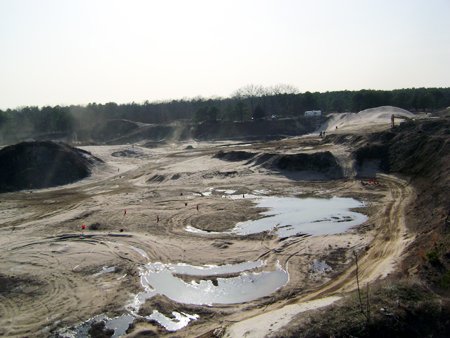Changes to proposed Island Water Park plan

The proposed Island Water Park in Calverton is dropping plans to have motorboats pull water skiers over a man-made lake at EPCAL, as well as plans to use another section of their 42 acre property for motorcross riders.
Instead, they now are proposing an alternate plan in which water skiers would be pulled over the man-made lake by an overhead cable.
The motorcross proposal would be dropped entirely.
Tom Cramer, a consultant for Island Water Park owner Eric Scott, discussed the changes with the Riverhead Town Board on Thursday, but he said obstacles at the state level still need to be resolved before the project, which was first proposed 13 years ago, can move forward.
Water skiing cables involve having a cable that is attached to a structure on either side of the water that pulled the skier mechanically. Such facilities exist in places like Florida and Texas and in other countries.
Island Water Park originally proposed to build a man-made lake for water skiing 13 years ago on Youngs Avenue, near the town landfill. But after neighbors objected, town officials at the time suggested they instead build the lake at EPCAL, and the town sold 42 acres there to Island Water Park for $714,000 in 2003.
The project received state and town approval, but when they started excavating the two ponds proposed, the developers hit the ground water table, and the state Department of Environmental Conservation stopped the project. Island Water Park, which originally planned to construct a plastic liner at the bottom of the ponds, then amended their plan to call for skiing directly on the water table, an idea which drew opposition from the Long Island Pine Barrens Society.
The plan was also the subject of litigation between the town and state over whether it and a proposed town park at EPCAL should be required to get approvals from the state’s Pine Barrens Commission.
Island Water Park later revised its plan again to call for one man-made lake, with a liner, where motor boats would pull water skiers, and for the other hole, where the second pond was originally planned, to instead be used for motorcross racing.
But Mr. Cramer said the DEC had concerns about that project too, and so it’s been redesigned to include only the one pond, with water cables instead of boats. The other hole would be refilled.
The water cable system is more expensive to build, although it runs on electricity and is very energy efficient, Mr. Cramer said.
“The cost of running it all day is equivalent to doing two loads of laundry,” he said.
The problem DEC has now is that the existing clearing of the land exceeds the 35 percent clearing limits within the Central Pine Barrens. Island Water Park is located in the compatible growth area of the Pine Barrens, where limited development is allowed, and it’s adjacent to the core area of the Pine Barrens, where no development is allowed.
Town officials have argued that when the town was given to Riverhead from the federal government, that development in EPCAL was supposed to be exempt from the requirements of the Pine Barrens protection act, which is the crux of the lawsuit between the town and state.
“The pine barrens act exempts everything within the fence and the DEC is being disingenuous,” Supervisor Sean Walter said. The Act would not have been passed without Riverhead’s approval in 1995 and the town at that time insisted that development within the fence at EPCAL be excluded.
But he said that exemption was never written into the act, but instead was only included in a comprehensive land use plan accompanying the act.
“Dick Amper hoodwinked the Town of Riverhead by not writing it into the act,” he said of the head of the Long Island Pine Barrens Society, who was instrumental in developing the Pine Barrens law.
Mr. Cramer said the state, which is the lead agency reviewing their application, will not accept a site plan that doesn’t conform to the Pine Barrens regulations.
One proposed solution he is putting forward is to have the town say that a certain amount of land it owns within the core be included toward the 35 percent clearing calculation.
Even thought that land is now owned by Island Water Park, Mr. Cramer argues there are provisions to allow such a proposal if the land is contiguous and if the town writes a covenant stating it will never been developed, which it wouldn’t anyway, since it’s in the Pine Barrens Core. If that is rejected, Island Water Park might have to buy more land to meet the clearing regs, and that would also require filing a subdivision application, he said.
In order for the second pond site to be refilled and re-vegitated so it could be included toward the 35 percent calculation, a hardship permit would be required from the Pine Barrens Commission, he said.
Mr. Walter said the town’s ultimate goal is to have a land use consultant examine the zoning at EPCAL, with possible changes proposed to the recreation zoning, and to subdivide the property into smaller blocks, in order to make it easier to sell in the future.
Mr. Walter said he is one of three town supervisors on the five-member Pine Barrens Commission, the others being Southampton Supervisor Anna Throne-Holst and Brookhaven supervisor Mark Lesko, and that he will try to get them to agree to the plan proposed by Mr. Cramer.
“We want to get you guys open,” he said.





